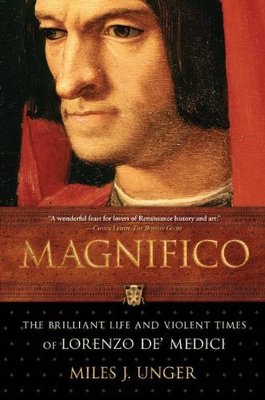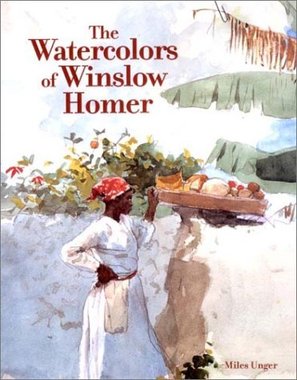|
Books
Miles J. Unger has published three books, Machiavelli: A Biography (2011), Magnifico: The Brilliant Life and Violent Times of Lorenzo de' Medici (2008), and The Watercolors of Winslow Homer (2001).
Machiavelli: A Biography - Now in Stores! He is the most infamous and influential political writer of all time. His name has
become synonymous with cynical scheming and the selfish pursuit of power.
Niccolo Machiavelli, the Florentine diplomat and civil servant, is the father of
political science. The Prince, his most notorious work, is a primer on how to acquire
and retain power without regard to scruple or conscience. His Discourses offers a
profound analysis of the workings of the civil state and a hard-headed assessment of
human nature. He is the most infamous and influential political writer of all time. His name has
become synonymous with cynical scheming and the selfish pursuit of power.
Niccolo Machiavelli, the Florentine diplomat and civil servant, is the father of
political science. The Prince, his most notorious work, is a primer on how to acquire
and retain power without regard to scruple or conscience. His Discourses offers a
profound analysis of the workings of the civil state and a hard-headed assessment of
human nature.
Machiavelli's philosophy was shaped by the tumultuous age in which he
lived, an age of towering geniuses and brutal tyrants. He was on intimate terms with
Leonardo and Michelangelo, and his first political mission was to spy on the fire-and-
brimstone preacher Savonarola. As a diplomat, he matched wits with the corrupt
and carnal Pope Alexander VI, and his son, the notorious Cesare Borgia whose
violent career served as a model for The Prince. His insights were gleaned by
studying up close men like Julius II, the "Warrior Pope" and his successor, the
vacillating Clement VII, as well as two kings of France and the Holy Roman Emperor.
Analyzing their successes and failures, Machiavelli developed his revolutionary
approach to power politics.
Machiavelli was, above all, a student of human nature. In The Prince he wrote
a practical guide to the aspiring politician that is based on the world as it is, not as it
should be. He has been called cold and calculating, cynical and immoral. In reality,
argues biographer Miles Unger, he was a deeply humane writer whose controversial
theories were a response to the violence and corruption he saw around him. He was
a psychologist with acute insight into human nature centuries before Freud. A
brilliant and witty writer, he was not only a political theorist but also a poet and the
author of La Mandragola, the greatest comedy of the Italian Renaissance. He has
been called the first modern man, unafraid to contemplate a world without God.
Rising from modest beginnings on the strength of his own talents, he was able to see
through the piety and hypocrisy of the age in which he lived.
Miles Unger has relied on original Italian sources as well as his own deep
knowledge of Florence in writing this fascinating and authoritative account of a
genius whose work remains as relevant today as when he wrote it.
Order Machiavelli: A Biography from Amazon
Order from Barnes & Noble
Magnifico: The Brilliant Life and Violent Times of Lorenzo de' Medici
 A true Renaissance man, Lorenzo de' Medici ruled Florence during its golden age. Known for his prodigious talents, magnetic personality, and political ruthlessness, Lorenzo was the leading statesman of his time and a renowned poet and legendary patron of the arts. In Magnifico, Miles Unger draws on primary research from Italian sources and an intimate knowledge of Florence to give us a biography as bold and colorful as its subject.
A true Renaissance man, Lorenzo de' Medici ruled Florence during its golden age. Known for his prodigious talents, magnetic personality, and political ruthlessness, Lorenzo was the leading statesman of his time and a renowned poet and legendary patron of the arts. In Magnifico, Miles Unger draws on primary research from Italian sources and an intimate knowledge of Florence to give us a biography as bold and colorful as its subject.
Born into the vastly wealthy and politically powerful Medici family, Lorenzo was nonetheless in a precarious position, his life under constant threat as a result of bitter rivalries among the leading Florentine families and competition among squabbling Italian states. But Lorenzo proved to be a cunning and skillful navigator on the treacherous seas of Italian politics. Not only did he survive, he presided over one of the great moments in the history of civilization, befriending the greatest artists and writers of the time--Leonardo, Botticelli, Poliziano, and the young Michelangelo.
Magnifico vividly captures an era of exceptional political intrigue, religious fervor, and artistic achievement, as embodied by one of its most famous characters.
Order Magnifico from Amazon in paperback, hardcover, or for Kindle
Order from Barnes & Noble
Order from IndieBound in hardcover or paperback
Reviews of Magnifico
"A Wonderful feast for lovers of Renaissance history and art."
--The Boston Globe
"This brilliant book is almost as much the biography of a city as of a man; one of its strengths is an ability to convey the cultural, political and sexual ambiance of 15th-century Florence with a rare clarity. The author explains how the passion for pagan classical myth of Lorenzo and the brilliant scholars, poets and artists with whom he liked to surround himself did not involve a rejection of Christianity: the search for God was an important part of Lorenzo’s spiritual life, and, like all Florentines, he was a member of the religious confraternities whose utterances and practices (including flagellation) would not have been out of step with the ferocious preaching of Savonarola. Membership of a confraternity was for Florentines like belonging to branches of political parties with all their opportunities for plotting and 'networking'"
--Sarah Bradford, The Spectator, June 28, 2008
"After finishing Miles Unger's dazzling new biography of Lorenzo de' Medici, my head was filled with myriad impressions of this book, but none more striking than this: Five centuries ago, at the height of the Italian Renaissance, the famed Florentine leader helped foster a remarkable flowering of art, architecture, literature and intellectual life that remains nearly unparalleled in history.
From the first sentence, "Magnifico" transports the reader to 15th-century Florence, a place of matchless splendor, both natural and man-made. Unger, a contributing writer on art for The New York Times, mines a rich lode of sources that include government records; historical accounts; diaries; and Lorenzo's own memoirs, letters and poems. The result is an indelible personal profile and an enthralling account of both the glories and brutality of the era."
--Seattle Times 2008
"This portrait of the 'uncrowned' ruler of Florence does great justice to this most intriguing of all Renaissance princes."
--Ross King, author of Brunelleschi's Dome
The Watercolors of Winslow Homer
 Picture Editor: Arnold Skolnick
Picture Editor: Arnold Skolnick
Winslow Homer (1836-1910) was not only one of America's greatest painters in oil but also an unrivaled master of the watercolor medium. From charming scenes of a rural childhood to epic landscapes that chronicle the many moods of nature, Homer's watercolors remain unmatched in their ambition and expressive power. Homer, along with artists like John Singer Sargent and John La Farge, helped usher in the first great age of American watercolor painting, setting the stage for the brilliant creations of such twentieth-century masters as Maurice Prendergest, Georgia O'Keeffe, John Marin, and Edward Hopper.
The Watercolors of Winslow Homer examines the artist's spectacular achievement in the medium, beginning in 1873 with his earliest watercolors depicting the carefree life of children playing at the shore, and concluding with the sparkling images he painted in the first years of the twentieth century that capture the tropical lushness of Florida, Bermuda, and the Bahamas. Along the way, Homer's watercolors embraced the variety of American life, from the New England coast to the rustic farms of upstate New York and Virginia. Homer's brush pictured both the genteel world of fashionable young ladies and the Adirondacks forests where rugged lumbermen and hunters plied their trade. Homer's travels also took him to the English coast where he painted somber, monumental watercolors of the storm-swept sea, and late in life to the Caribbean where the warm sun inspired some of his most colorful and sensuous works. Above all, Homer was a confirmed outdoorsman, and the watercolors he painted in the forests and lakes of the Adirondacks and Quebec are among the most profound evocations of natural beauty ever created.
Homer's greatest contribution to watercolor was to expand the possibilities of the medium, investing fragile works on paper with a visual and moral weight. His watercolors not only depict the beauty of the wilderness but also document a fragile ecosystem under threat from human exploitation. Of the close to 700 watercolors that have survived, The Watercolors of Winslow Homer reproduces over 140 works, including both recognized masterpieces and little-known gems. Homer himself seemed to recognize his achievement, writing late in life to his brother Charles, "You will see, in the future I will live by my Watercolors."
Order The Watercolors of Winslow Homer from Amazon
Order from Barnes & Noble
Order from IndieBound
|


 He is the most infamous and influential political writer of all time. His name has
become synonymous with cynical scheming and the selfish pursuit of power.
Niccolo Machiavelli, the Florentine diplomat and civil servant, is the father of
political science. The Prince, his most notorious work, is a primer on how to acquire
and retain power without regard to scruple or conscience. His Discourses offers a
profound analysis of the workings of the civil state and a hard-headed assessment of
human nature.
He is the most infamous and influential political writer of all time. His name has
become synonymous with cynical scheming and the selfish pursuit of power.
Niccolo Machiavelli, the Florentine diplomat and civil servant, is the father of
political science. The Prince, his most notorious work, is a primer on how to acquire
and retain power without regard to scruple or conscience. His Discourses offers a
profound analysis of the workings of the civil state and a hard-headed assessment of
human nature.